air condition MAZDA MODEL 3 HATCHBACK 2007 Owner's Manual (in English)
[x] Cancel search | Manufacturer: MAZDA, Model Year: 2007, Model line: MODEL 3 HATCHBACK, Model: MAZDA MODEL 3 HATCHBACK 2007Pages: 402, PDF Size: 5.66 MB
Page 3 of 402

Black plate (3,1)
Thank you for choosing a Mazda. We at Mazda design and build vehicles with complete
customer satisfaction in mind.
To help ensure enjoyable and trouble-free operation of your Mazda, read this manual
carefully and follow its recommendations.
An Authorized Mazda Dealer knows your vehicle best. So when maintenance or service is
necessary, that's the place to go.
Our nationwide network of Mazda professionals is dedicated to providing you with the best
possible service.
We assure you that all of us at Mazda have an ongoing interest in your motoring pleasure
and in your full satisfaction with your Mazda product.
Mazda Motor Corporation
HIROSHIMA, JAPAN
Important Notes About This Manual
Keep this manual in the glove box as a handy reference for the safe and enjoyable use of your Mazda. Should you
resell the vehicle, leave this manual with it for the next owner.
All specifications and descriptions are accurate at the time of printing. Because improvement is a constant goal at
Mazda, we reserve the right to make changes in specifications at any time without notice and without obligation.
Event Data Recorder
This vehicle is equipped with an event data recorder. In the event of a crash, this device records data related to
vehicle dynamics and safety systems for a short period of time. These data can help provide a better
understanding of the circumstances in which crashes and injuries occur and lead to the designing of safer
vehicles.
Air Conditioning and the Environment
Your Mazda's genuine air conditioner is filled with HFC134a (R134a), a refrigerant that has been found not to
damage the earth's ozone layer. If the air conditioner does not operate properly, consult an Authorized Mazda
Dealer.
Please be aware that this manual applies to all models, equipment and options. As a result, you may find
some explanations for equipment not installed on your vehicle.
©2006 Mazda Motor Corporation
Printed in Japan Oct. 2006(Print3)
A Word to Mazda Owners
Mazda3_8V66-EA-06F_Edition3 Page3
Wednesday, August 23 2006 11:18 AM
Form No.8V66-EA-06F
Page 5 of 402
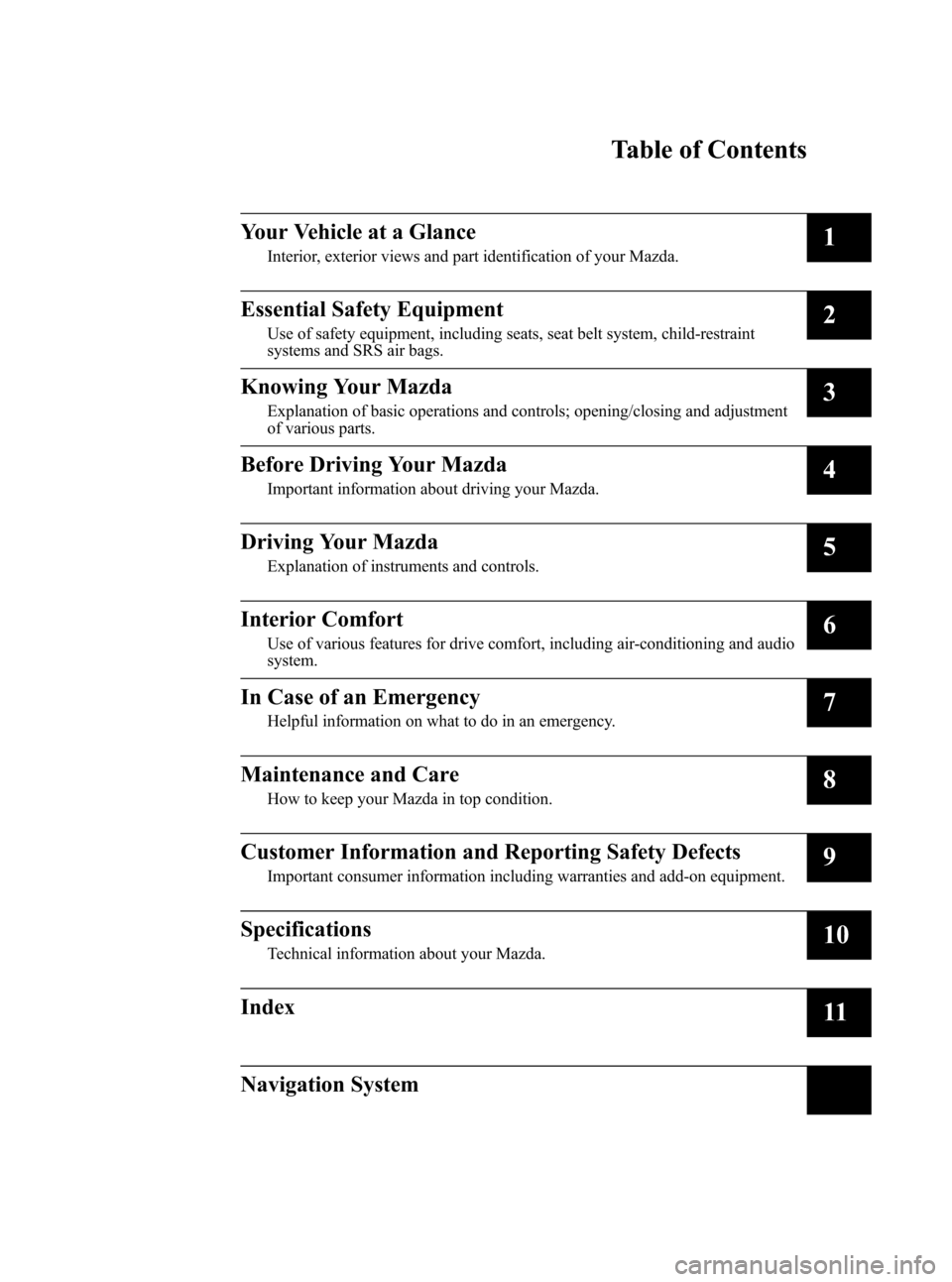
Black plate (5,1)
Mazda3_8V66-EA-06F_Edition3 Page5
Wednesday, August 23 2006 11:18 AM
Form No.8V66-EA-06F
Table of Contents
Your Vehicle at a Glance
Interior, exterior views and part identification of your Mazda.1
Essential Safety Equipment
Use of safety equipment, including seats, seat belt system, child-restraint
systems and SRS air bags.2
Knowing Your Mazda
Explanation of basic operations and controls; opening/closing and adjustment
of various parts.3
Before Driving Your Mazda
Important information about driving your Mazda.4
Driving Your Mazda
Explanation of instruments and controls.5
Interior Comfort
Use of various features for drive comfort, including air-conditioning and audio
system.6
In Case of an Emergency
Helpful information on what to do in an emergency.7
Maintenance and Care
How to keep your Mazda in top condition.8
Customer Information and Reporting Safety Defects
Important consumer information including warranties and add-on equipment.9
Specifications
Technical information about your Mazda.10
Index11
Navigation System
Page 40 of 402
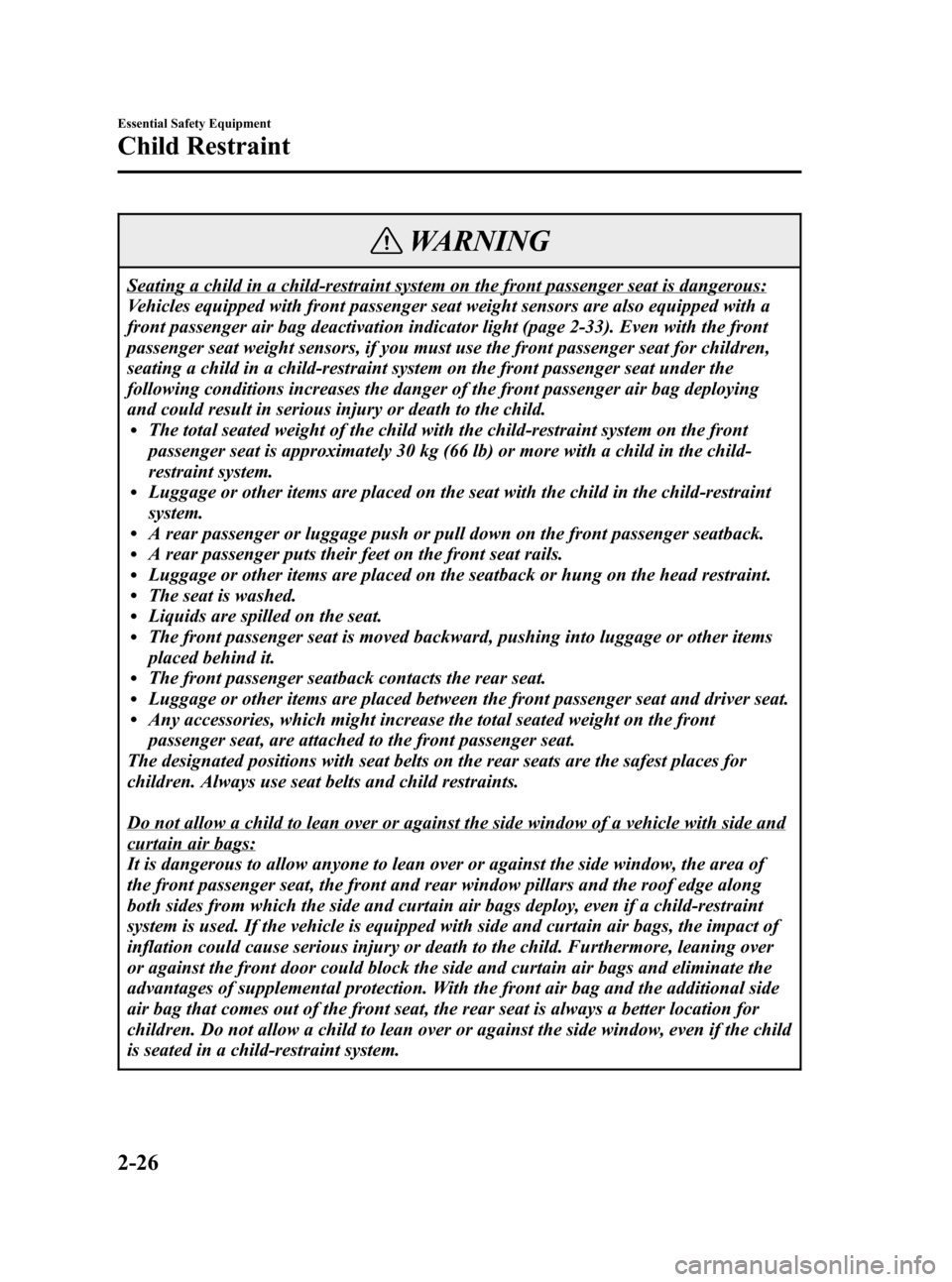
Black plate (40,1)
WARNING
Seating a child in a child-restraint system on the front passenger seat is dangerous:
Vehicles equipped with front passenger seat weight sensors are also equipped with a
front passenger air bag deactivation indicator light (page 2-33). Even with the front
passenger seat weight sensors, if you must use the front passenger seat for children,
seating a child in a child-restraint system on the front passenger seat under the
following conditions increases the danger of the front passenger air bag deploying
and could result in serious injury or death to the child.
lThe total seated weight of the child with the child-restraint system on the front
passenger seat is approximately 30 kg (66 lb) or more with a child in the child-
restraint system.
lLuggage or other items are placed on the seat with the child in the child-restraint
system.
lA rear passenger or luggage push or pull down on the front passenger seatback.lA rear passenger puts their feet on the front seat rails.lLuggage or other items are placed on the seatback or hung on the head restraint.lThe seat is washed.lLiquids are spilled on the seat.lThe front passenger seat is moved backward, pushing into luggage or other items
placed behind it.
lThe front passenger seatback contacts the rear seat.lLuggage or other items are placed between the front passenger seat and driver seat.lAny accessories, which might increase the total seated weight on the front
passenger seat, are attached to the front passenger seat.
The designated positions with seat belts on the rear seats are the safest places for
children. Always use seat belts and child restraints.
Do not allow a child to lean over or against the side window of a vehicle with side and
curtain air bags:
It is dangerous to allow anyone to lean over or against the side window, the area of
the front passenger seat, the front and rear window pillars and the roof edge along
both sides from which the side and curtain air bags deploy, even if a child-restraint
system is used. If the vehicle is equipped with side and curtain air bags, the impact of
inflation could cause serious injury or death to the child. Furthermore, leaning over
or against the front door could block the side and curtain air bags and eliminate the
advantages of supplemental protection. With the front air bag and the additional side
air bag that comes out of the front seat, the rear seat is always a better location for
children. Do not allow a child to lean over or against the side window, even if the child
is seated in a child-restraint system.
2-26
Essential Safety Equipment
Child Restraint
Mazda3_8V66-EA-06F_Edition3 Page40
Wednesday, August 23 2006 11:18 AM
Form No.8V66-EA-06F
Page 65 of 402
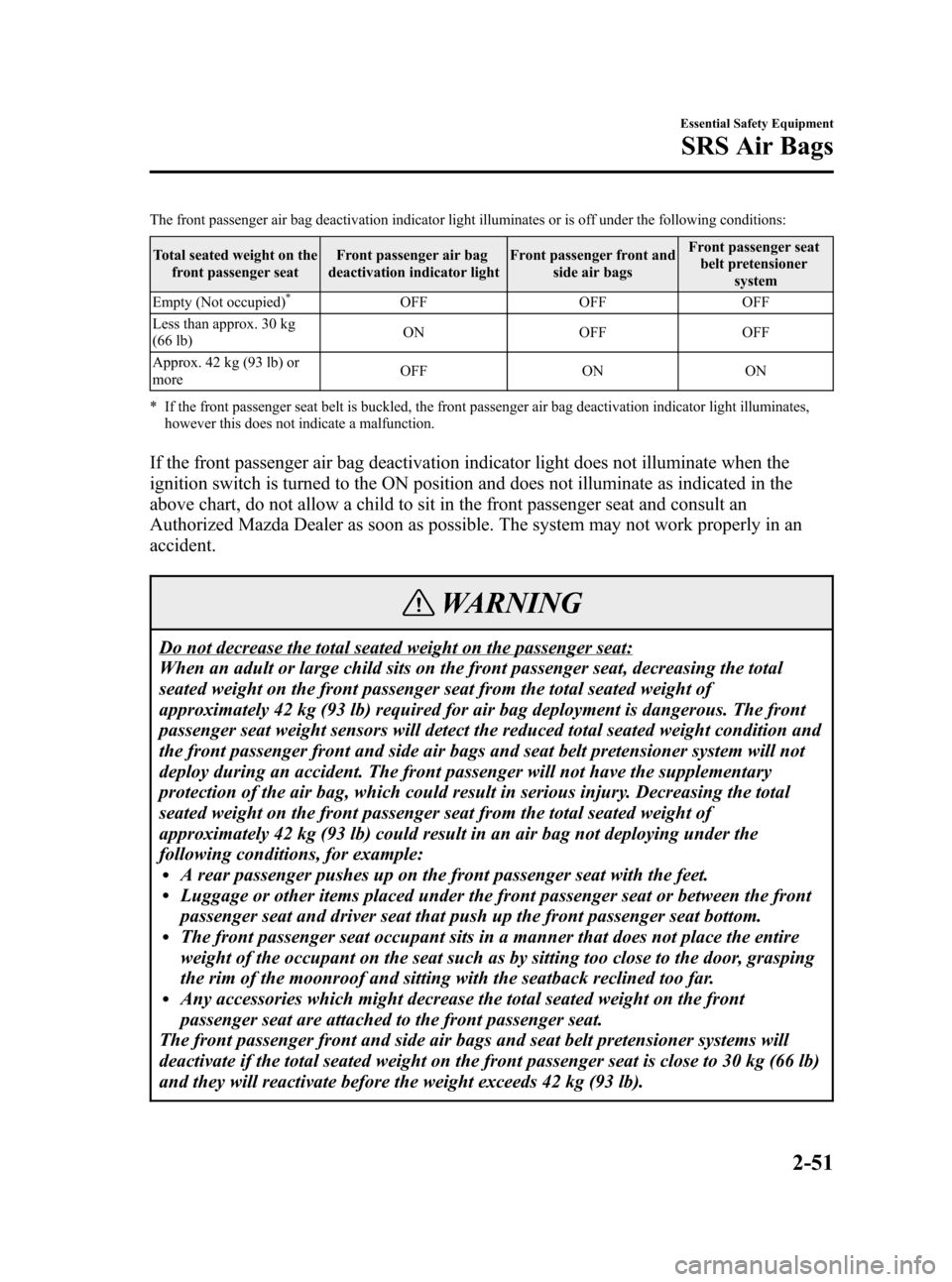
Black plate (65,1)
The front passenger air bag deactivation indicator light illuminates or is off under the following conditions:
Total seated weight on the
front passenger seatFront passenger air bag
deactivation indicator lightFront passenger front and
side air bagsFront passenger seat
belt pretensioner
system
Empty (Not occupied)
*OFF OFF OFF
Less than approx. 30 kg
(66 lb)ON OFF OFF
Approx. 42 kg (93 lb) or
moreOFF ON ON
* If the front passenger seat belt is buckled, the front passenger air bag deactivation indicator light illuminates,
however this does not indicate a malfunction.
If the front passenger air bag deactivation indicator light does not illuminate when the
ignition switch is turned to the ON position and does not illuminate as indicated in the
above chart, do not allow a child to sit in the front passenger seat and consult an
Authorized Mazda Dealer as soon as possible. The system may not work properly in an
accident.
WARNING
Do not decrease the total seated weight on the passenger seat:
When an adult or large child sits on the front passenger seat, decreasing the total
seated weight on the front passenger seat from the total seated weight of
approximately 42 kg (93 lb) required for air bag deployment is dangerous. The front
passenger seat weight sensors will detect the reduced total seated weight condition and
the front passenger front and side air bags and seat belt pretensioner system will not
deploy during an accident. The front passenger will not have the supplementary
protection of the air bag, which could result in serious injury. Decreasing the total
seated weight on the front passenger seat from the total seated weight of
approximately 42 kg (93 lb) could result in an air bag not deploying under the
following conditions, for example:
lA rear passenger pushes up on the front passenger seat with the feet.lLuggage or other items placed under the front passenger seat or between the front
passenger seat and driver seat that push up the front passenger seat bottom.
lThe front passenger seat occupant sits in a manner that does not place the entire
weight of the occupant on the seat such as by sitting too close to the door, grasping
the rim of the moonroof and sitting with the seatback reclined too far.
lAny accessories which might decrease the total seated weight on the front
passenger seat are attached to the front passenger seat.
The front passenger front and side air bags and seat belt pretensioner systems will
deactivate if the total seated weight on the front passenger seat is close to 30 kg (66 lb)
and they will reactivate before the weight exceeds 42 kg (93 lb).
Essential Safety Equipment
SRS Air Bags
2-51
Mazda3_8V66-EA-06F_Edition3 Page65
Wednesday, August 23 2006 11:18 AM
Form No.8V66-EA-06F
Page 66 of 402
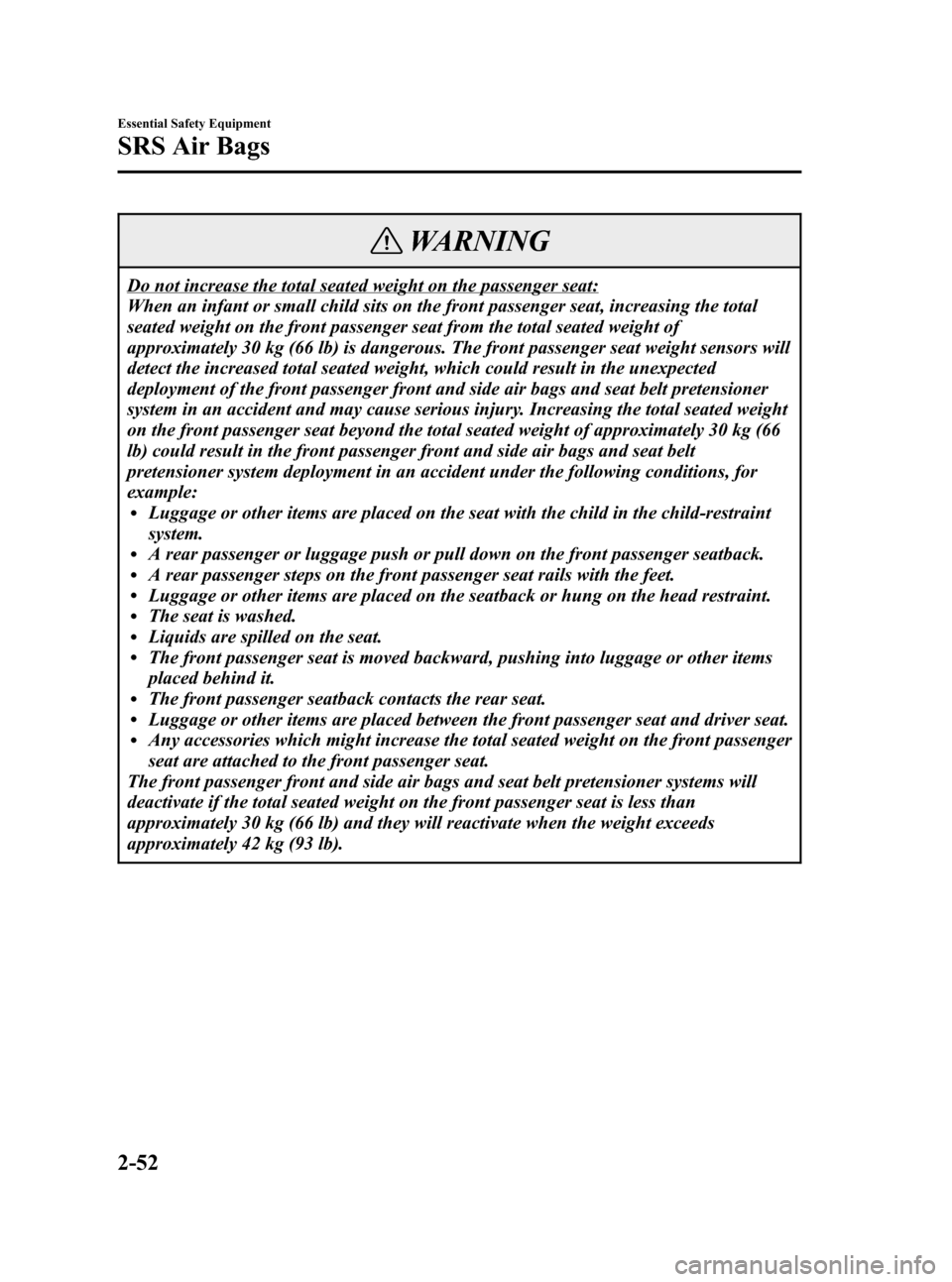
Black plate (66,1)
WARNING
Do not increase the total seated weight on the passenger seat:
When an infant or small child sits on the front passenger seat, increasing the total
seated weight on the front passenger seat from the total seated weight of
approximately 30 kg (66 lb) is dangerous. The front passenger seat weight sensors will
detect the increased total seated weight, which could result in the unexpected
deployment of the front passenger front and side air bags and seat belt pretensioner
system in an accident and may cause serious injury. Increasing the total seated weight
on the front passenger seat beyond the total seated weight of approximately 30 kg (66
lb) could result in the front passenger front and side air bags and seat belt
pretensioner system deployment in an accident under the following conditions, for
example:
lLuggage or other items are placed on the seat with the child in the child-restraint
system.
lA rear passenger or luggage push or pull down on the front passenger seatback.lA rear passenger steps on the front passenger seat rails with the feet.lLuggage or other items are placed on the seatback or hung on the head restraint.lThe seat is washed.lLiquids are spilled on the seat.lThe front passenger seat is moved backward, pushing into luggage or other items
placed behind it.
lThe front passenger seatback contacts the rear seat.lLuggage or other items are placed between the front passenger seat and driver seat.lAny accessories which might increase the total seated weight on the front passenger
seat are attached to the front passenger seat.
The front passenger front and side air bags and seat belt pretensioner systems will
deactivate if the total seated weight on the front passenger seat is less than
approximately 30 kg (66 lb) and they will reactivate when the weight exceeds
approximately 42 kg (93 lb).
2-52
Essential Safety Equipment
SRS Air Bags
Mazda3_8V66-EA-06F_Edition3 Page66
Wednesday, August 23 2006 11:18 AM
Form No.8V66-EA-06F
Page 73 of 402
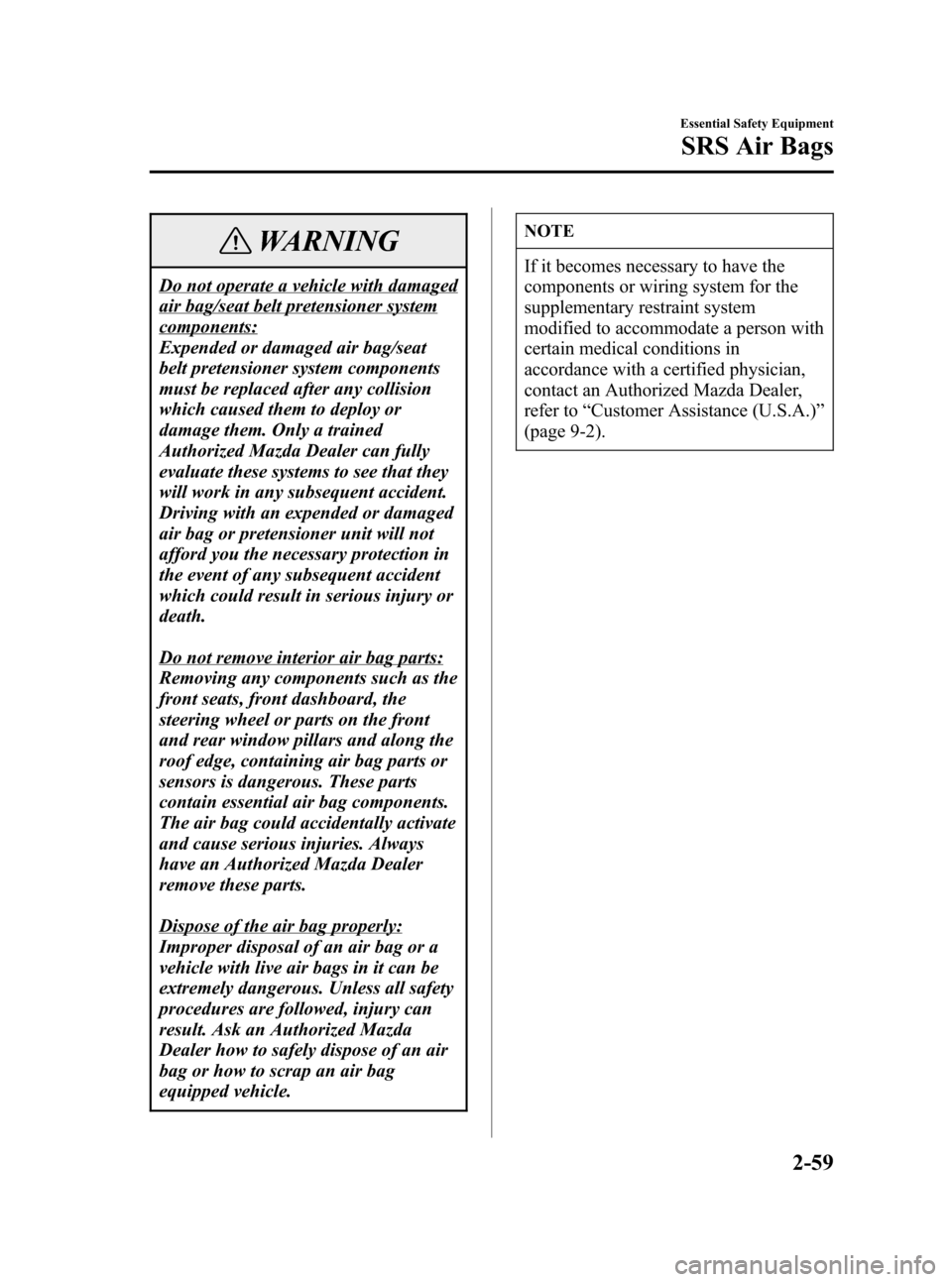
Black plate (73,1)
WARNING
Do not operate a vehicle with damaged
air bag/seat belt pretensioner system
components:
Expended or damaged air bag/seat
belt pretensioner system components
must be replaced after any collision
which caused them to deploy or
damage them. Only a trained
Authorized Mazda Dealer can fully
evaluate these systems to see that they
will work in any subsequent accident.
Driving with an expended or damaged
air bag or pretensioner unit will not
afford you the necessary protection in
the event of any subsequent accident
which could result in serious injury or
death.
Do not remove interior air bag parts:
Removing any components such as the
front seats, front dashboard, the
steering wheel or parts on the front
and rear window pillars and along the
roof edge, containing air bag parts or
sensors is dangerous. These parts
contain essential air bag components.
The air bag could accidentally activate
and cause serious injuries. Always
have an Authorized Mazda Dealer
remove these parts.
Dispose of the air bag properly:
Improper disposal of an air bag or a
vehicle with live air bags in it can be
extremely dangerous. Unless all safety
procedures are followed, injury can
result. Ask an Authorized Mazda
Dealer how to safely dispose of an air
bag or how to scrap an air bag
equipped vehicle.
NOTE
If it becomes necessary to have the
components or wiring system for the
supplementary restraint system
modified to accommodate a person with
certain medical conditions in
accordance with a certified physician,
contact an Authorized Mazda Dealer,
refer to“Customer Assistance (U.S.A.)”
(page 9-2).
Essential Safety Equipment
SRS Air Bags
2-59
Mazda3_8V66-EA-06F_Edition3 Page73
Wednesday, August 23 2006 11:18 AM
Form No.8V66-EA-06F
Page 115 of 402

Black plate (115,1)
Break-In Period
No special break-in is necessary, but a few
precautions in the first 1,000 km (600
miles) may add to the performance,
economy, and life of your Mazda.
lDon't race the engine.
lDon't maintain one constant speed,
either slow or fast, for a long period of
time.
lDon't drive constantly at full-throttle or
high engine rpm for extended periods
of time.
lAvoid unnecessary hard stops.
lAvoid full-throttle starts.
Money-Saving Suggestions
How you operate your Mazda determines
how far it will travel on a tank of fuel. Use
these suggestions to help save money on
fuel and repairs.
lAvoid long warm-ups. Once the engine
runs smoothly, begin driving.
lAvoid fast starts.
lKeep the engine tuned. Follow the
maintenance schedule (page 8-3) and
have an Authorized Mazda Dealer
perform inspections and servicing.
lUse the air conditioner only when
necessary.
lSlow down on rough roads.
lKeep the tires properly inflated.
lDon't carry unnecessary weight.
lDon't rest your foot on the brake pedal
while driving.
lKeep the wheels in correct alignment.
lKeep windows closed at high speeds.
lSlow down when driving in crosswinds
and headwinds.
WARNING
Never stop the engine when going
down a hill:
Stopping the engine when going down
a hill is dangerous. This causes the
loss of power steering and power
brake control, and may cause damage
to the drivetrain. Any loss of steering
or braking control could cause an
accident.
Before Driving Your Mazda
Driving Tips
4-7
Mazda3_8V66-EA-06F_Edition3 Page115
Wednesday, August 23 2006 11:19 AM
Form No.8V66-EA-06F
Page 149 of 402
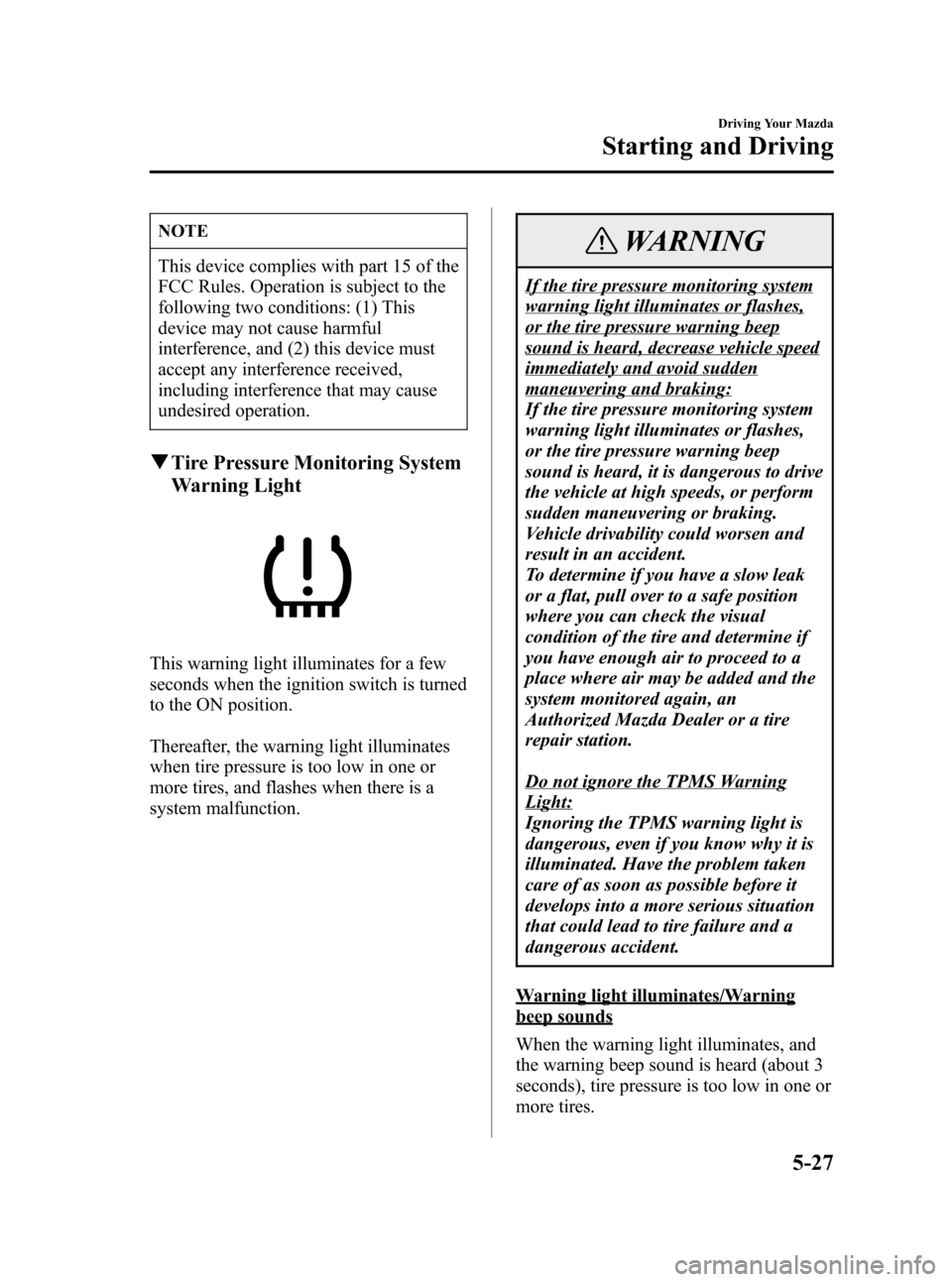
Black plate (149,1)
NOTE
This device complies with part 15 of the
FCC Rules. Operation is subject to the
following two conditions: (1) This
device may not cause harmful
interference, and (2) this device must
accept any interference received,
including interference that may cause
undesired operation.
qTire Pressure Monitoring System
Warning Light
This warning light illuminates for a few
seconds when the ignition switch is turned
to the ON position.
Thereafter, the warning light illuminates
when tire pressure is too low in one or
more tires, and flashes when there is a
system malfunction.
WARNING
If the tire pressure monitoring system
warning light illuminates or flashes,
or the tire pressure warning beep
sound is heard, decrease vehicle speed
immediately and avoid sudden
maneuvering and braking:
If the tire pressure monitoring system
warning light illuminates or flashes,
or the tire pressure warning beep
sound is heard, it is dangerous to drive
the vehicle at high speeds, or perform
sudden maneuvering or braking.
Vehicle drivability could worsen and
result in an accident.
To determine if you have a slow leak
or a flat, pull over to a safe position
where you can check the visual
condition of the tire and determine if
you have enough air to proceed to a
place where air may be added and the
system monitored again, an
Authorized Mazda Dealer or a tire
repair station.
Do not ignore the TPMS Warning
Light:
Ignoring the TPMS warning light is
dangerous, even if you know why it is
illuminated. Have the problem taken
care of as soon as possible before it
develops into a more serious situation
that could lead to tire failure and a
dangerous accident.
Warning light illuminates/Warning
beep sounds
When the warning light illuminates, and
the warning beep sound is heard (about 3
seconds), tire pressure is too low in one or
more tires.
Driving Your Mazda
Starting and Driving
5-27
Mazda3_8V66-EA-06F_Edition3 Page149
Wednesday, August 23 2006 11:19 AM
Form No.8V66-EA-06F
Page 164 of 402
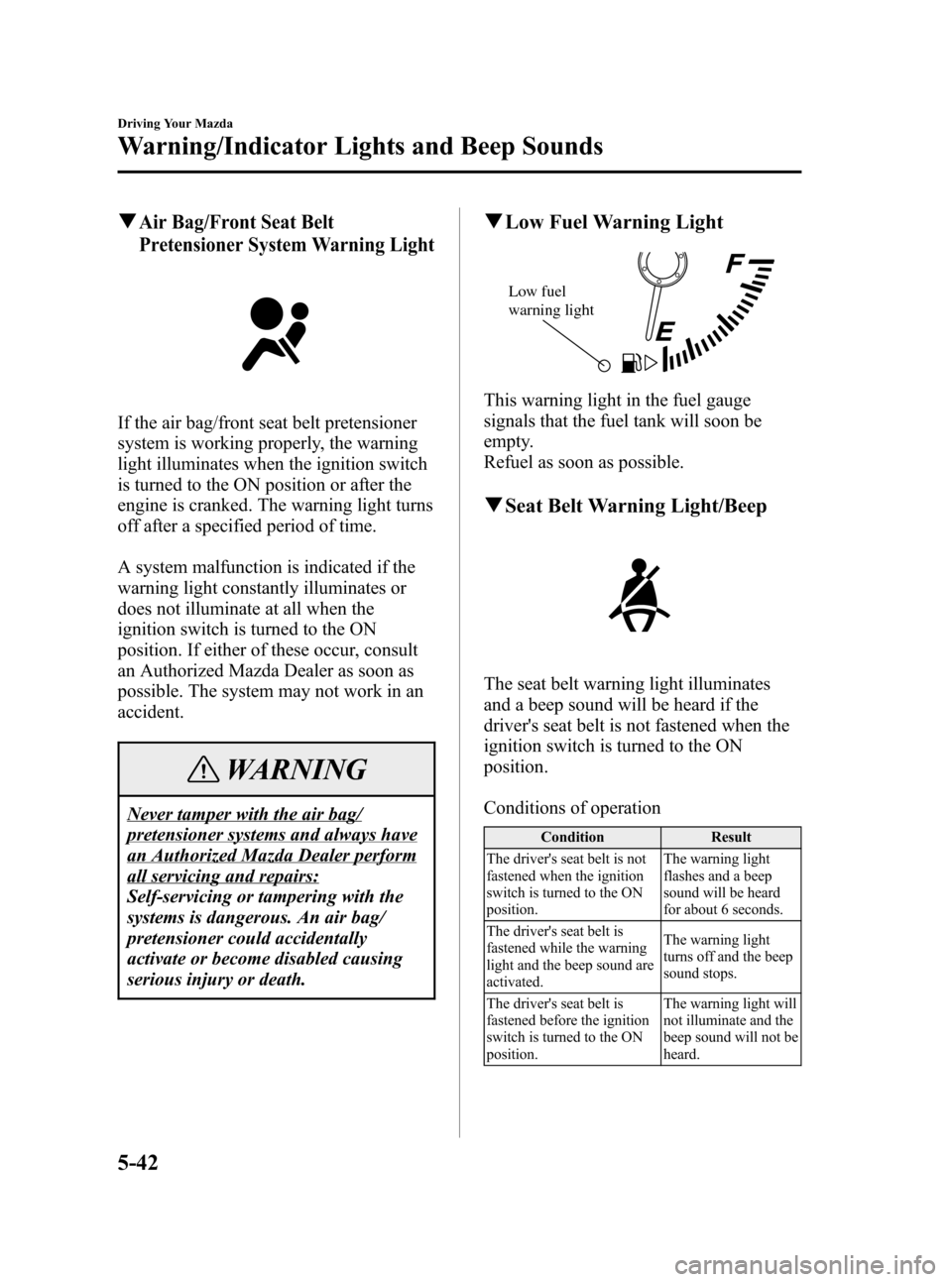
Black plate (164,1)
qAir Bag/Front Seat Belt
Pretensioner System Warning Light
If the air bag/front seat belt pretensioner
system is working properly, the warning
light illuminates when the ignition switch
is turned to the ON position or after the
engine is cranked. The warning light turns
off after a specified period of time.
A system malfunction is indicated if the
warning light constantly illuminates or
does not illuminate at all when the
ignition switch is turned to the ON
position. If either of these occur, consult
an Authorized Mazda Dealer as soon as
possible. The system may not work in an
accident.
WARNING
Never tamper with the air bag/
pretensioner systems and always have
an Authorized Mazda Dealer perform
all servicing and repairs:
Self-servicing or tampering with the
systems is dangerous. An air bag/
pretensioner could accidentally
activate or become disabled causing
serious injury or death.
qLow Fuel Warning Light
Low fuel
warning light
This warning light in the fuel gauge
signals that the fuel tank will soon be
empty.
Refuel as soon as possible.
qSeat Belt Warning Light/Beep
The seat belt warning light illuminates
and a beep sound will be heard if the
driver's seat belt is not fastened when the
ignition switch is turned to the ON
position.
Conditions of operation
Condition Result
The driver's seat belt is not
fastened when the ignition
switch is turned to the ON
position.The warning light
flashes and a beep
sound will be heard
for about 6 seconds.
The driver's seat belt is
fastened while the warning
light and the beep sound are
activated.The warning light
turns off and the beep
sound stops.
The driver's seat belt is
fastened before the ignition
switch is turned to the ON
position.The warning light will
not illuminate and the
beep sound will not be
heard.
5-42
Driving Your Mazda
Warning/Indicator Lights and Beep Sounds
Mazda3_8V66-EA-06F_Edition3 Page164
Wednesday, August 23 2006 11:19 AM
Form No.8V66-EA-06F
Page 167 of 402

Black plate (167,1)
WARNING
If the tire pressure monitoring system
warning light illuminates or flashes,
or the tire pressure warning beep
sound is heard, decrease vehicle speed
immediately and avoid sudden
maneuvering and braking:
If the tire pressure monitoring system
warning light illuminates or flashes,
or the tire pressure warning beep
sound is heard, it is dangerous to drive
the vehicle at high speeds, or perform
sudden maneuvering or braking.
Vehicle drivability could worsen and
result in an accident.
To determine if you have a slow leak
or a flat, pull over to a safe position
where you can check the visual
condition of the tire and determine if
you have enough air to proceed to a
place where air may be added and the
system monitored again, an
Authorized Mazda Dealer or a tire
repair station.
Do not ignore the TPMS Warning
Light:
Ignoring the TPMS warning light is
dangerous, even if you know why it is
illuminated. Have the problem taken
care of as soon as possible before it
develops into a more serious situation
that could lead to tire failure and a
dangerous accident.
Warning light illuminates/Warning
beep sounds
When the warning light illuminates, and
the warning beep sound is heard (about 3
seconds), tire pressure is too low in one or
more tires.Adjust the tire pressure to the correct tire
pressure. Refer to the specification charts
(page 10-8).
CAUTION
When replacing/repairing the tires or
wheels or both, have the work done by
an Authorized Mazda Dealer, or the tire
pressure sensors may be damaged.
NOTE
lPerform tire pressure adjustment
when the tires are cold. Tire pressure
will vary according to the tire
temperature, therefore let the vehicle
stand for 1 hour or only drive it
1.6 km (1 mile) or less before
adjusting the tire pressures. When
pressure is adjusted on hot tires to
the cold inflation pressure, the TPMS
warning light/beep may turn on after
the tires cool and pressure drops
below specification.
Also, an illuminated TPMS warning
light, resulting from the tire air
pressure dropping due to cold
ambient temperature, may go out if
the ambient temperature rises. In this
case, it will also be necessary to
adjust the tire air pressures. If the
TPMS warning light illuminates due
to a drop in tire air pressure, make
sure to check and adjust the tire air
pressures.
Driving Your Mazda
Warning/Indicator Lights and Beep Sounds
5-45
Mazda3_8V66-EA-06F_Edition3 Page167
Wednesday, August 23 2006 11:19 AM
Form No.8V66-EA-06F